Pet food labels report the nutrient content of their products using the Guaranteed Analysis.
These contents are listed in terms of minimums and maximums, which are, by definition, inaccurate.
For instance, if the guaranteed analysis lists a minimum of 10% protein, it may well contain much more than that.
But it’s what we have to work with, and it at least indicates the macronutrient content of the food:
- Protein – reported as a minimum amount
- Fat – reported as a minimum amount
- Fiber – reported as a maximum amount
- Ash – if this is included, it is reported as a maximum amount. (Ash is an indication of the mineral content)
- Moisture - the water content
The Guaranteed Analysis lists each nutrient as a percentage of the total weight in the food, as fed.
That is to say, the percentages include the weight of water in the food.
Comparing cat food on a “dry matter basis,” often designated simply as “DMB,” takes into account the differences in water content so just the nutrients can be compared on a common basis.
How Water Affects the Guaranteed Analysis
Take one tablespoon of protein powder that weighs half an ounce.
Add 8 ounces of water to it. The total weight is 8.5 ounces.
The protein powder is 6% of this “food,” and the moisture content is 94%.
Take another tablespoon of protein powder of the same weight, and add 16 ounces of water to it, for a total weight of 16.5 ounces.
Now protein powder is just 3% of the “food,” and the moisture content is 97%.
On a “guaranteed analysis,” these “foods” would be portrayed as:
“Guaranteed Analysis” of Example Foods

But we put the same amount of protein powder into each!
It is the weight of the water that makes the foods look so different despite the nutrients in this food being exactly the same!
This illustrates why direct comparisons of foods with different moisture contents cannot be made with the guaranteed analysis because the percentages are based on the total weight of the food that contains the water weight.
SIGN UP FOR THECATSITE'S EMAIL UPDATES >
How to Determine Dry Matter Basis
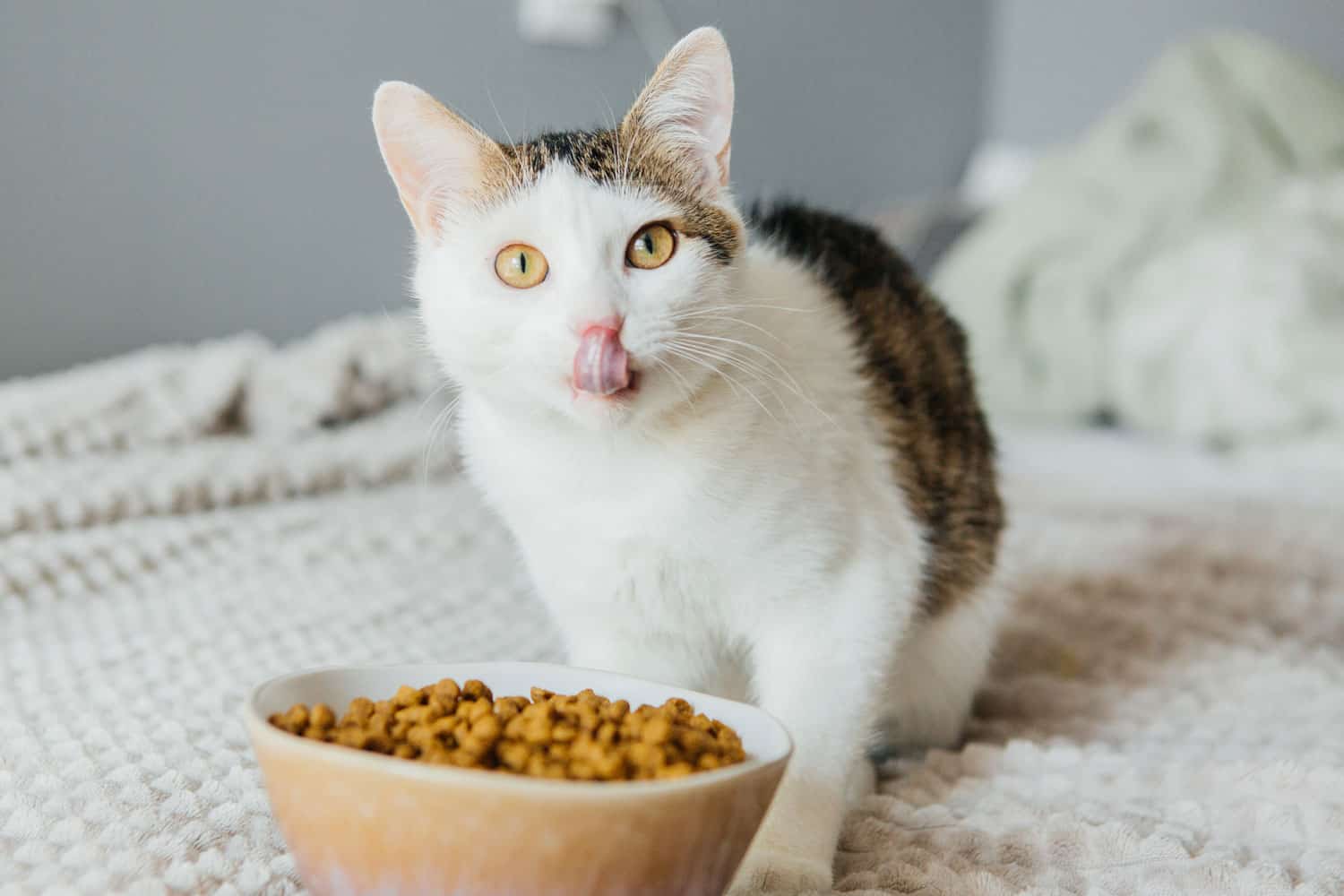
Step 1: “Remove” the water.
To determine just the nutrient composition of the food, the water must be mathematically removed.
Food 1: 100% (total weight of product) - 94% (the “moisture content” in the guaranteed analysis) = 6% (dry matter content: just the nutrients).
Food 2: 100% (total weight of product) - 97% (the “moisture content” in the guaranteed analysis) = 3% (dry matter content: just the nutrients).
In this example, Food 1 has a dry matter content of 6% and Food 2 has a dry matter content of 3%.
Step 2: Calculate each nutrient as a percent of the dry matter content
To do this, take the percentage of each nutrient as listed in the guaranteed analysis, and divide it into the dry matter content of the food, calculated in step 1.
Continuing with our example of protein powder in water, we know that protein powder was the only item added to the water, so protein should be 100% of the dry matter content of each food:
Food 1: 6% (protein listed on the guaranteed analysis) ÷ 6% (the amount of dry matter content in the food) = 100%
Food 2: 3% (protein listed on the guaranteed analysis) ÷ 3% (the amount of dry matter content in the food) = 100%.
Each food is 100% protein on a dry matter basis.
Analyzing Cat Food
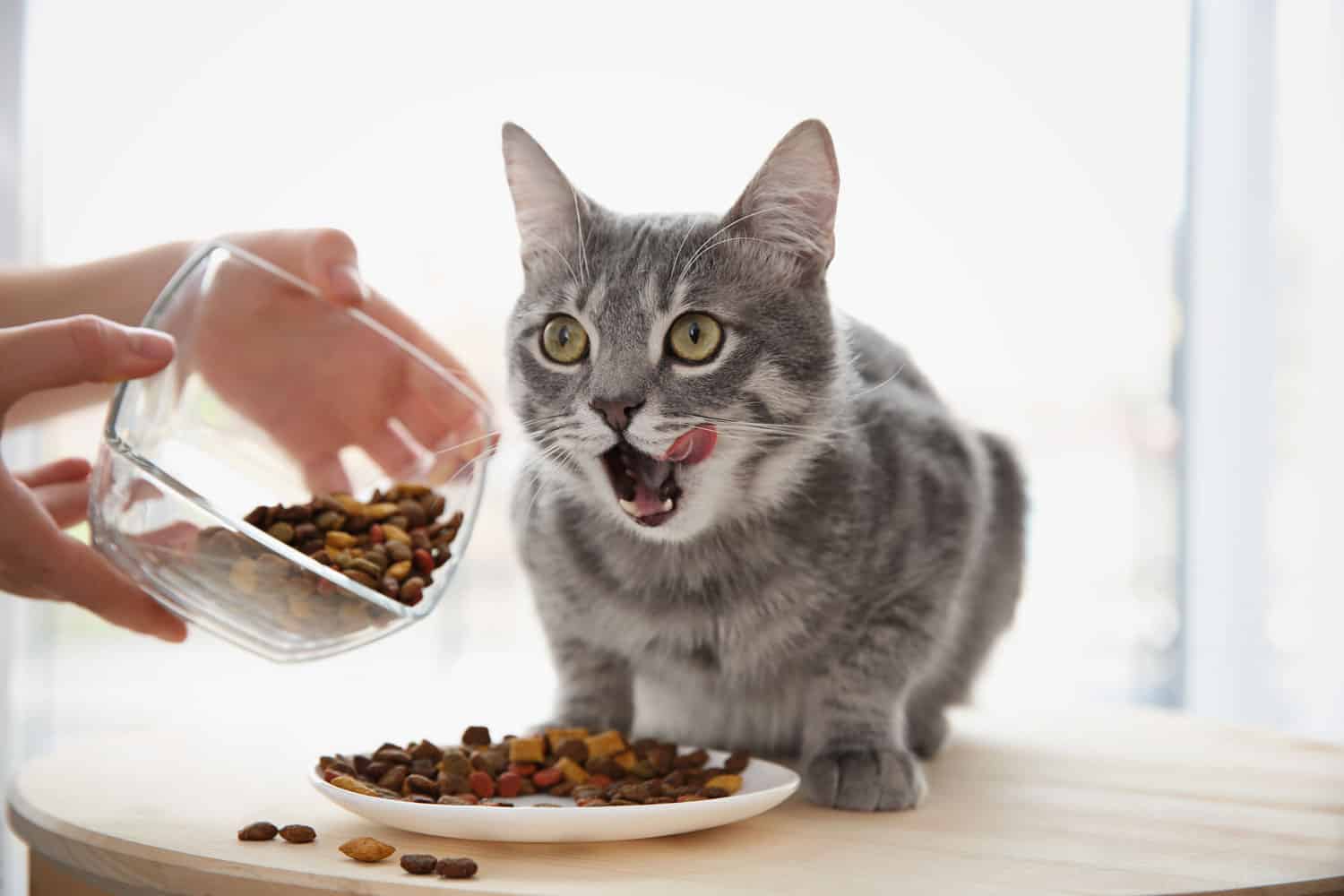
But there’s more than just protein in cat food. Here is an example of how to convert the guaranteed analysis provided on cat food labels to a dry matter basis.
The steps are the same.
Example of Guaranteed Analysis on cat food labels
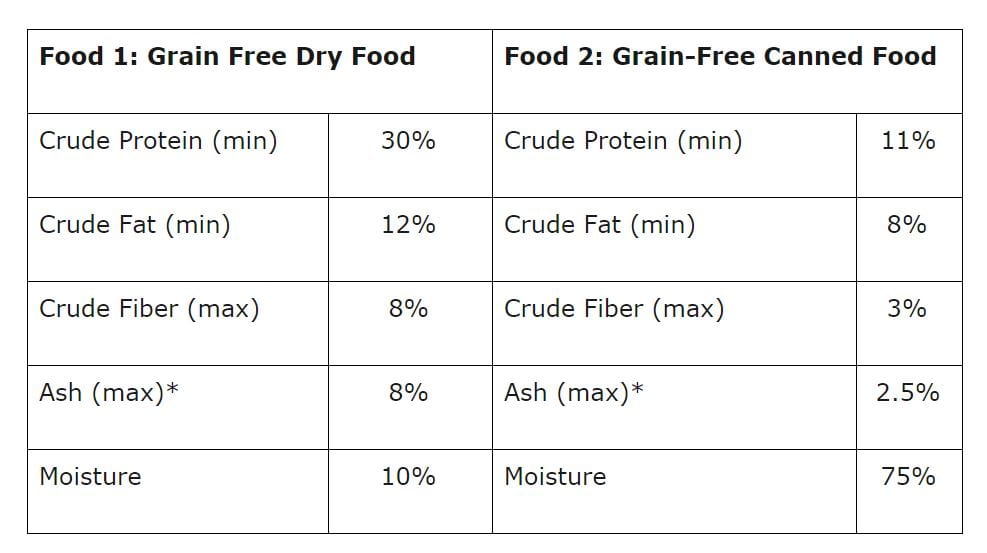
*Ash is not required to be listed in the guaranteed analysis.
The information will sometimes be on the manufacturer's website.
Though the amount of ash will vary, a rule of thumb is that dry food will contain approximately 8% ash, and canned food will contain approximately 2.5% ash, as fed.
Whether or not ash is listed in the guaranteed analysis does not impact the dry matter basis conversion.
At first glance, it appears that Food #1 is much higher in protein than Food #2.
But as pointed out, the percentages of the nutrients include the water in the food because the guaranteed analysis is presented “as fed.”
To analyze only the nutrients in the food, we follow the same process as above.
Step 1: “Remove” the water.
Cat Food 1 (dry food): 100% (total weight of product) - 10% (water weight) = 90% (dry matter content).
Cat Food 2 (canned food): 100% (total weight of product) - 75% (water weight) = 25% (dry matter content).
In this example, Food 1 has a dry matter content of 90%. Food 2 has a dry matter content of 25%.
Step 2: Calculate each nutrient as a percent of the dry matter content
Food 1 (dry food):
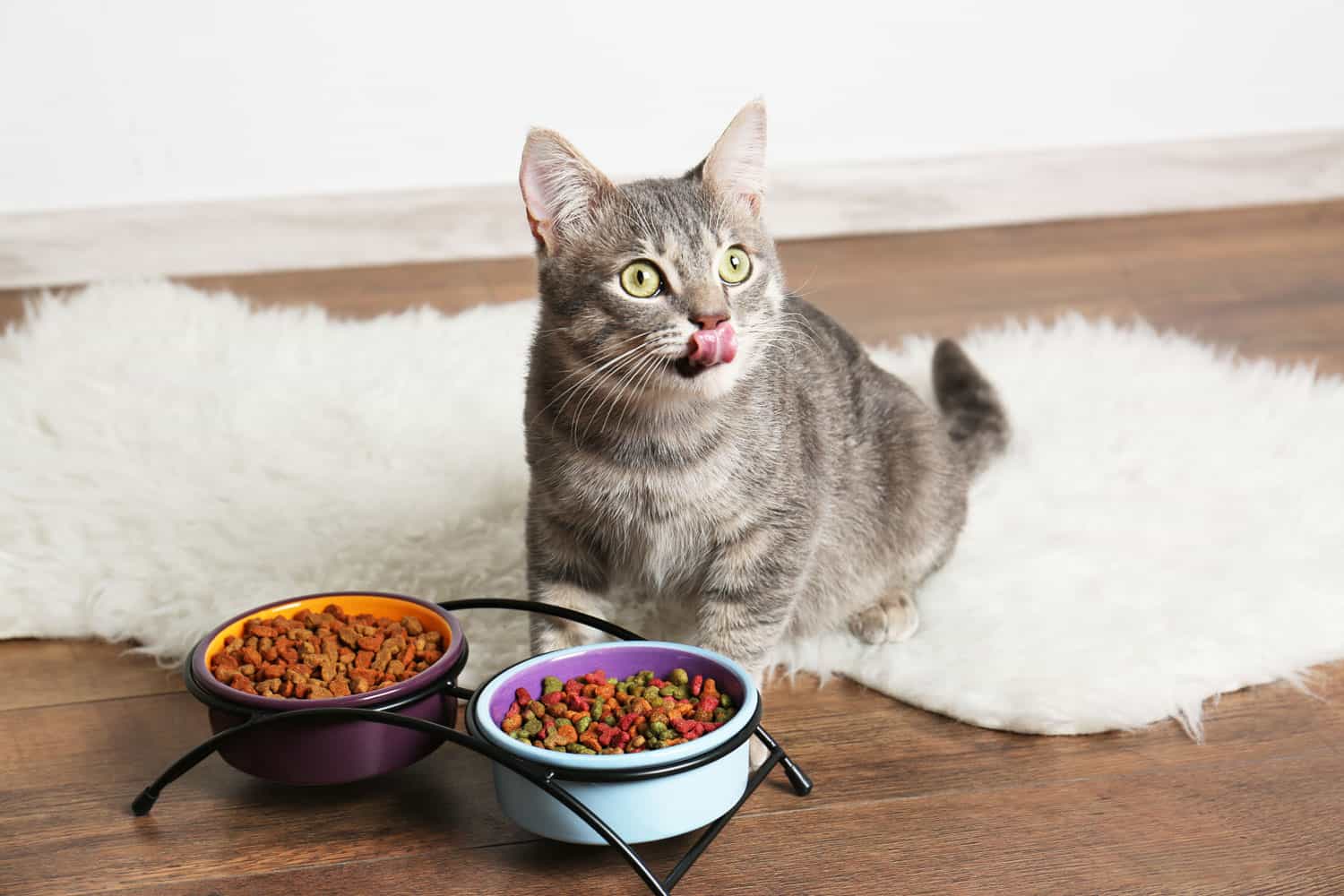
- Protein: Using the 30% protein content as listed in the guaranteed analysis on the label and the 90% dry matter content from our calculation: 30% / 90% = 33% protein on a dry matter basis.
- Fat: Using the 12% fat content from the label and the 90% dry matter content from our calculation: 12% / 90% = 13% fat on a dry matter basis.
- Fiber: Using the 8% fiber content from the label and the 90% dry matter content from our calculation: 8% / 90% = 9% fiber on a dry matter basis.
- Ash: (if provided). Using the 8% ash content from the label and the 90% dry matter content from our calculation: 8% / 90% = 9% ash on a dry matter basis.
Food 2 (canned food):
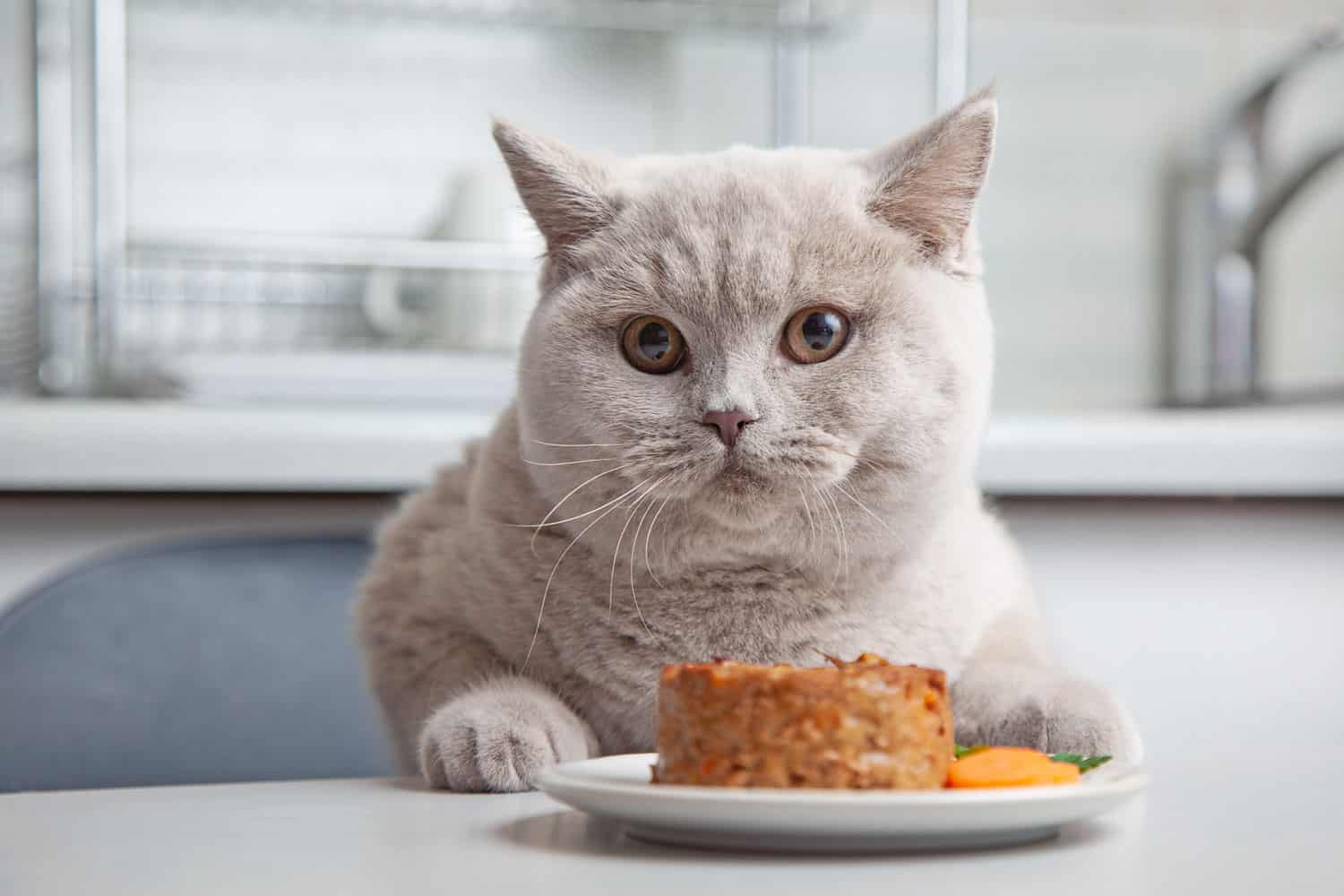
- Protein: Using the 11% protein content as listed in the guaranteed analysis on the label and the 25% dry matter content from our calculation: 11% / 25% = 44% protein on a dry matter basis.
- Fat: Using the 8% fat content from the label and the 25% dry matter content from our calculation: 8% / 25% = 32% fat on a dry matter basis.
- Fiber: Using the 3% fiber content from the label and the 25% dry matter content from our calculation: 3% / 25% = 12% fiber on a dry matter basis.
- Ash: (if provided). Using the 2.5% ash content from the label and the 25% dry matter content from our calculation: 2.5% / 25% = 10% ash on a dry matter basis.
Dry Matter Basis Comparison
| Food 1: G.F. Dry Food | DMB | Food 2: G. F. Canned Food | DMB | |||
| Crude Protein (min) |
33% |
Crude Protein (min) |
44% |
|||
| Crude Fat (min) |
13% |
Crude Fat (min) |
32% |
|||
| Crude Fiber (max) |
9% |
Crude Fiber (max) |
12% |
|||
| Ash (max) |
9% |
Ash (max) |
10% |
|||
Because of its high moisture content, in the guaranteed analysis, the canned food looked like it was a lower protein and has less fat and fiber than the dry food.
But once adjusted for the water content, we can see it is much higher protein than the dry food.
You can download a Dry Matter Basis (DMB) Conversion from CatCentric.org.
Calculating Carbohydrates In Cat Food
To calculate the approximate carbohydrate content of cat food, we need to first convert the food to a dry matter basis, as illustrated above.
Then it’s just a matter of simple math. The contents of a cat food must total 100%.
Based on the examples above:
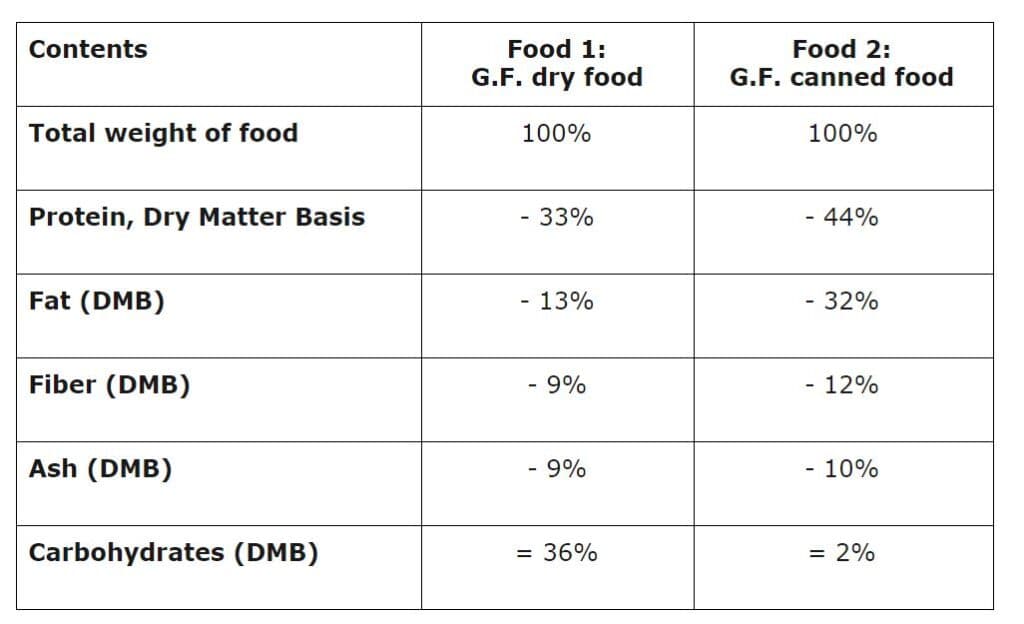
Some manufacturers provide the average or typical nutrient content on their websites.
Using that information is more accurate when converting cat food to a dry matter basis or when calculating carbohydrates.
With pet food labeling based on “minimums” and “maximums,” a food that works out to be 8% carbs today could easily be 14% carbs with the next batch, and vice versa.
SIGN UP FOR THECATSITE'S EMAIL UPDATES >
Written by Laurie Goldstein
Laurie Goldstein is a CFA Charterholder. In addition to her work as an equity analyst, she applies her research skill to all things cat, focusing on nutrition and advocacy for feral cat management via trap-neuter-return (TNR) and educational research on cat predation. Learn more about feral cats on her website Stray Pet Advocacy.
Comments? Leave them using the comment section below. Questions? Please use the cat forums for those!
Note: We may get commissions for purchases made through links on this page.


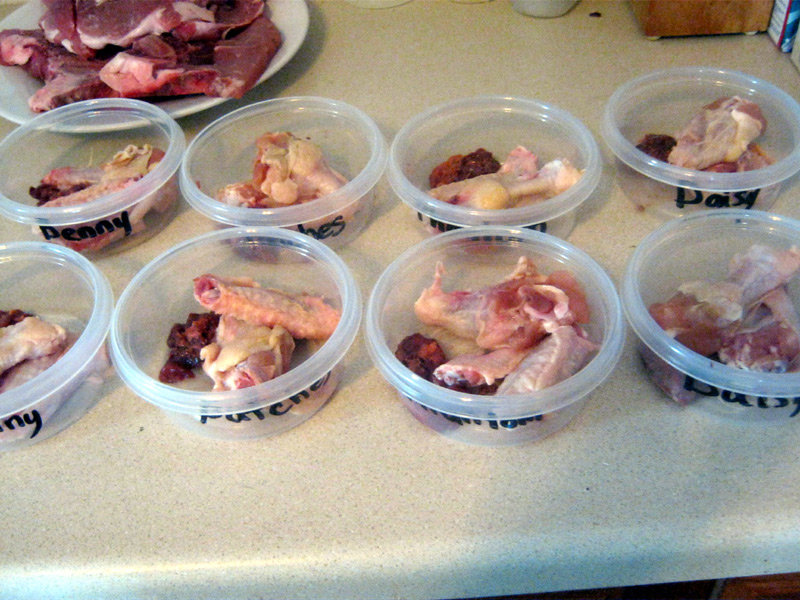
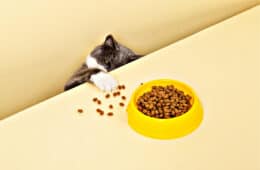
4 comments on “How To Compare Cat Foods & Calculate Carbs [Dry Matter Basis]”